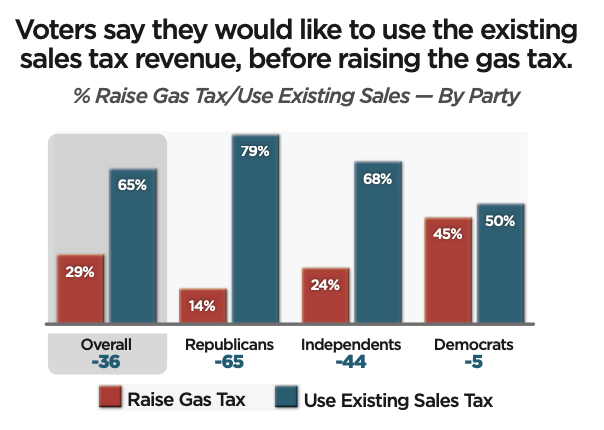Testing the waters
American Experiment’s public opinion survey finds Minnesota hostile to a gas tax increase, favoring spending restraint and wary of financially unstable public pensions.
As Minnesota’s legislators proceeded through the final days of their 2015 session, Center of the American Experiment released a public opinion survey that revealed, among other things, that a bipartisan majority of Minnesotans staunchly rejected the notion of a statewide gas tax increase by a whopping two-to-one margin. Minnesotans also appeared to be surprisingly unified on issues related to the budget, health care, and state pensions, perhaps explained by their perception of the state’s improving economy.
This first-ever State of Prosperity survey was conducted by Rob Autry, one of the nation’s leading pollsters and research strategists. His Charleston, SC-based firm, Meeting Street Research, interviewed 500 registered voters statewide by telephone (30 percent by cell phone) between April 26-28. This survey has a margin of error of plus or minus 4.38 percent.
The survey was created to supplement the abundant success of the Center’s Minnesota Policy Blueprint, a wide-ranging anthology of market-oriented policy recommendations published in January.
“The Blueprint did an outstanding job of laying out a conservative agenda for legislators,” said Tom Mason, the consultant who conceived and managed both the Blueprint and the State of Prosperity survey on behalf of the Center.
“But policy-makers also benefit from knowing how concepts resonate with the public.” The State of Prosperity did exactly that, he said.
The survey earned lead editorials in both the St. Paul Pioneer Press and the Minnesota StarTribune.
Among other things, the State of Prosperity survey revealed the following results:

Spending:
Minnesotans oppose using the proceeds of the state’s expected $1.9 billion budget surplus to fund new or expand existing government programs. Only 13 percent favor such spending. Voters would rather see the surplus saved for a rainy day (39 percent) and used to cut future taxes (38 percent). On top of this, there was deep bipartisan support (64 percent) for the notion of limiting how much lawmakers can increase state spending, such as limiting the growth in spending to the growth in inflation or personal income (36 percent strong support, 27 percent somewhat support). This idea enjoyed the broadest support of all the issues tested, cutting across all demographics: 76 percent from Republicans, 65 percent from Independents, and 53 percent from Democrats.
“Minnesotans expect lawmakers to spend tax dollars responsibly,” said Peter Nelson, the Center’s director of public policy. “So it’s not too surprising that people across the partisan divide support setting reasonable limits on spending.”
Transportation:
A whopping 94 percent of Minnesotans favor public spending on modernizing and expand- ing aging roads, highways, and bridges. They overwhelmingly favor funding improvements through use of existing sales tax revenue (65 percent) over raising the gas tax (29 percent). “This is telling data,” said pollster Autry. Republicans overwhelmingly reject the gas tax (79 percent to 14 percent), but so did Independents (68 percent to 24 percent).
Attorney Fritz Knaak, a former state senator and coauthor of the Blueprint’s chapter on transportation, said the overwhelming support for prioritizing transportation funding “is the key takeaway from this, particularly when coupled with such a consistent opposition to gas tax funding. It’s clear that Minnesotans expect their leaders to find the means within the current revenue sources to get the job done.”
Health Care: When asked to name the ONE thematic solution that best contains the rising costs of health care, Minnesotans dramatically favor increased competition in health insurance (59 percent) over single-payer health care in which all Americans would get their health insurance from one health plan that is financed by taxes (35 percent).
Said Nelson: “Various laws on the books stifle value-enhancing competition in health care markets, but it’s not always clear whether the public under- stands this fact. It’s good to see that Minnesotans appreciate how competition can improve health care, just as it improves so many other things in our daily lives, like phones, cars and the restaurants we frequent.”
Public Pensions:
A majority (51 percent) of Minnesotans thinks that the financial insolvency of the state’s sys- tem of public pensions poses a potential future problem. Nearly two-thirds (64 percent) think public employees should transition to a kind of 401(k)-style pension system that is commonly used by private sector employers.
“Bringing the public sector into line with the private sector has many virtues,” says the Center’s executive vice president Kim Crockett, long a leading advocate of pension reform. “Besides offering fully funded, mobile retirement assets to young employees, it ends the unsound practice of taking on new, unfunded liabilities that are guaranteed by taxpayers. This makes it more likely that we can fully honor the promises we have already made, but not fully funded, to retirees and long-time employees. It also takes the backroom politics out of retirement savings and investments.